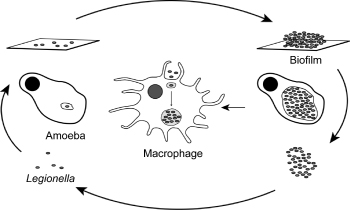PD Dr. Hubert Hilbi

Currently at the Ludwig Maximilians University of Munich
Virulence and communication of intracellular environmental bacteria
|
Environmental bacteria are inhaled via aerosols and may cause severe respiratory diseases. The bacteria resist free-living amoebae and other predators by forming biofilms on surfaces or by growing intracellularly. Amoebae-resistant bacteria infect and kill in the lung specific immune cells termed macrophages. As a model for amoebae-resistant environmental bacteria, we use the intracellular bacterium Legionella pneumophila, the causative agent of the pneumonia “Legionnaires’ disease”. |
|
Legionella pneumophila replicates in host cells in a unique, membrane-bound compartment, the Legionella vacuole. These vacuoles are formed by means of more than 100 different bacterial proteins, which are translocated through a secretion system into the cell, where they modulate biological processes in favor of the intruding agent.
We use macrophages and environmental protozoa, including the genetically tractable amoeba Dictyostelium discoideum, as well as phagocytes of the fruit fly Drosophila melanogaster, to analyze with biochemical, molecular and cell biological methods the mechanisms of L. pneumophila pathogenicity. The following questions are the focus of our research:
- Which bacterial and host factors interact how and when to form Legionella vacuoles?
- How do L. pneumophila bacteria communicate among each other and with different microorganisms via small signaling molecules to regulate virulence, adhesion and growth?
Our research contributes to identifying novel factors against amoebae-resistant bacteria and to controlling the growth of these pathogens in water systems.

